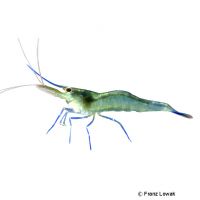Blue Leg Poso Shrimp (Caridina caerulea)
| Blue Leg Poso Shrimp Caridina caerulea | |
|---|---|
| Name | Blue Leg Poso Shrimp |
| Name Lat. | Caridina caerulea |
| Family | Shrimps |
| Family lat. | Atyidae |
| Order | Decapoda |
| Order lat. | Decapoda |
| Origin | Sulawesi |
| Habitat | Lake Poso |
| Diet | Omnivore |
| pH | 7.5-8.5 |
| Behavior | Peaceful |
| Keeping | Group |
| Care Level | Difficult |
| Reproduction | Oviparous |
| Breeding | Difficult |
| Life Span | 1-2 years |
| Protection | No |
| Metric Units | |
| Size | 3.5 cm |
| Temperature | 28-30 °C |
| Hardness | 5-10 °dH |
| Aquarium | 30 l |
| US Units | |
| Size | 1.4" |
| Temperature | 82-86 °F |
| Hardness | 89-178 ppm |
| Aquarium | 10 gal |
Distribution and habitat
The blue-footed shrimp are found exclusively (endemically) in Lake Poso on Sulawesi (Indonesia). They mostly live in the rocky areas near the shore in shallow water.
Maintenance
They require an aquarium structured with roots, rocks and coarse debris and a moderately strong current. Planting with Java moss or other small plants is recommended for visual reasons. The substrate of dark sand or gravel should be partially covered with foliage (e.g. almond leaves, oak leaves), decaying plant material and mulm.
No ammonia, ammonium and nitrite should be detectable in the aquarium water, the nitrate value should not exceed 100 mg/l. To ensure the water quality and oxygen content, a filter and heater adapted to the size of the aquarium is required, as well as lighting for the species-appropriate day-night rhythm of the animals. When choosing the filter, special care should be taken to ensure that the animals cannot be sucked in.
Diet
In nature, they use the bristles of their scissor legs to rasp off growth organisms from stones, dead wood and plants
They can be fed well with autumn leaves of native trees (e.g. oak, beech, maple, birch), sea almond tree leaves as well as fresh, scalded nettle or dandelion leaves, spirulina algae and special shrimp food with low protein content (below 30%), plus spinach, freshly scalded or frozen. It is recommended to coat stones or roots with a slurry of spirulina, chlorella and other algae powder and place them in the aquarium after they have dried. Dry food for fish and crayfish, frozen or freeze-dried food as well as live food such as cyclops, daphnia, Artemia nauplii and microworms should only be offered occasionally due to the high protein content.
It is sufficient to feed them about 3 times a week. Unaccepted food should be siphoned off after about 12 hours. Regular and varied feeding promotes the well-being of the animals.
Behaviour and compatibility
They should be kept in a group of at least 10 animals. Keeping them in a species tank is recommended, but they can also be kept with small peaceful fish, snails (e.g. Tylomelania) and other dwarf shrimp in a community tank with lots of moss and fine-feathered plants (hiding places).
Basically, only compatible animals with similar requirements to the water condition and water temperature may be socialized.
Reproduction and breeding
The sex difference is difficult to see. The slightly larger females have an egg spot on the nape of the neck.
From 10-15 large eggs hatch about 1.5 mm large, widely developed juveniles, which immediately hide in rock or bottom crevices and begin to search for food. The sensitive juveniles require especially clean water. The use of a UV sterilization system is recommended. Breeding in the aquarium has been successful several times
Important
The foliage (sea almond tree, oak, beech, etc.) not only provides cover, but also promotes the development of microorganisms as they decay, providing a valuable secondary food source. The soft, slightly alkaline water should not cool significantly even overnight. Feeding cucumbers, zucchini, peas, carrots, potatoes and peppers is discouraged.
The well-being of the animals should be checked regularly. Temperature should be checked daily, pH, hardness and nitrate levels at least every 14 days. Regular partial water changes are recommended, even if the contaminant level has not yet reached the upper limit. Sudden changes in water quality should be avoided. Newly introduced animals must be accustomed slowly to the water in the aquarium.
Further literature can be found in your pet store.
References
Text: petdata; Image: Franz Lowak
Source: KARGE & KLOTZ (2008): Süßwassergarnelen aus aller Welt, Dähne Verlag; ENGELMANN & LANGE (2011): Zootierhaltung - Tiere in menschlicher Obhut: Wirbellose, Verlag Harri Deutsch
